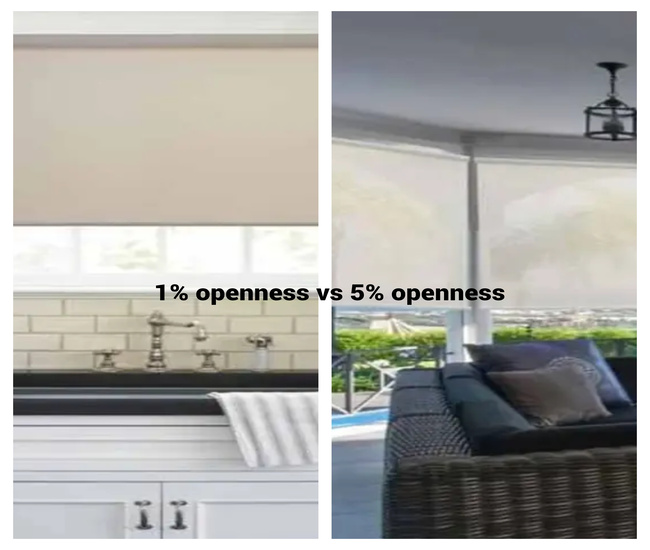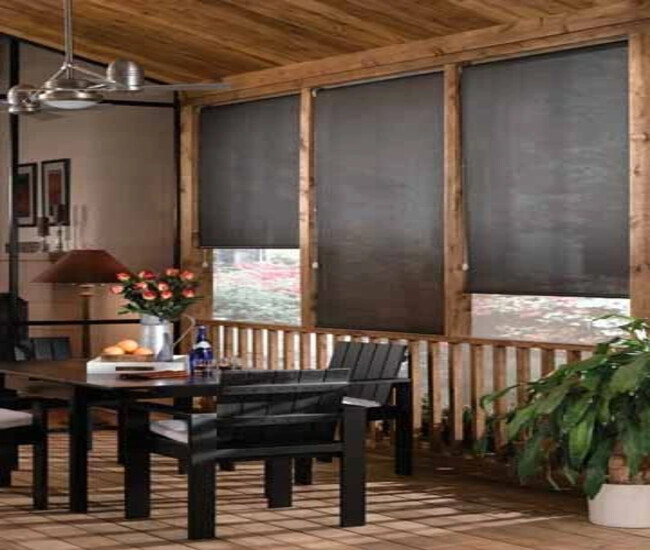Solar shades have various openness percentages. An openness percentage means the level of UV protection you will get. For example, a solar shade with a 3% openness factor will block out 97% of the sun’s harsh ultraviolet rays and allow 3% of them to pass through the window opening. Here is a comprehensive guide about “What does the openness percentage mean for solar shades?”
What are the Different Openness Percentages for Solar Shades?

Different openness percentages for solar shades usually range from 1% to 14 percent. However, these window treatments with higher openness factors are also available.
- 1% Openness Percentage: Solar Window shades with a one percent openness factor allow only one percent of the sun’s ultraviolet rays to pass through the window opening, and they block out the remaining 99% of them.
- 3% Openness Percentage: Three percent openness means that your solar window treatments will protect your furniture and other precious possession from 97 of the sun’s harsh rays. Also, they will provide more visibility than solar blinds with 1% openness percentage.
- 5% Openness Percentage: In this case, your window coverings will prevent 95% of the solar radiation from passing into your room.
- 10% Openness Percentage: Ten percent openness percentage will provide less protection against UV rays and more visibility than those with lower percentages. Also, solar shades with 10% of openness will reduce the sun’s glare and allow more natural light into your home.
- 14% Openness Percentage: As the very name suggest, solar shades with 14% openness percentage will block out 86% of the sun’s harsh rays, while allowing 14% of them to sail into your room’s interior. Premium solar shades with 14-openness offer a higher level of openness than standard. Higher openness levels allow you to see more sunlight but keep your view largely private. To ensure privacy, you will need to cover solar shades with curtains.
How do Openness Percentages Affect Visibility, Privacy, and Light Control?
The percentage of openness in solar shades can determine the amount of visibility, privacy, and light control they provide. The higher the percentage, the more light can pass through. A lower openness percentage, on the other hand, prevents much of the light from entering a room, resulting in greater darkness.
If you are concerned about visibility at night, you can layer solar shades with curtains to increase privacy. Meanwhile, dark-colored blinds are ideal if you are seeking more privacy and daytime heat blockage.
Solar screen shades are constructed from open-weave translucent fabric. This type of material is often used to create shade for a patio or outdoor space.
When to Choose Higher Openness Percentages
Look for solar shades with a higher openness percentage of 10 or more to let more natural light in the room, while keeping heat and glare outside.
What Determines the Openness Percentage of Solar Shades?
The tightness of the weave determines the openness value of solar shades. The higher the percentage, the looser the weave, and the less visibility or privacy is allowed. A low openness percentage will not allow as much light through and interfere with the view more than a higher openness factor.
Custom Options for Solar Shades

In addition to the openness factor, solar shades can be purchased in a variety of sizes. For the best look, you can buy a smaller shade with a higher openness percentage.
Also, solar shades are now available in many styles, colors, and textures.
What is the Openness Percentage of Blackout Solar Shades?
Blackout solar shades are great for blocking 100% of the sun’s UV rays. This protects furniture from heat damage and prevents excessive heat. They also provide privacy when they are lowered. This type of window treatment is attached to the window frame. So, you need to choose the right shade for your windows.
Blackout solar shades block light and prevent view-through. These shades offer privacy and security. Whether you’re looking for privacy in your home, or you’re enhancing the viewing experience of your media room, blackout shades can solve your problem. If you mount these shades outside the window opening, they will overlap the edges of the opening. Because of the overlapping edges, a tiny bit of light will be visible around the edges of the shade.
Installation and Maintenance of Solar Shades

Solar shades with different openness factors are easy to install and maintain. They are operated by a cord lift or a cordless lift mechanism. These shades can be placed inside or outside of the window frame and can also be left open at night. They can be cleaned and maintained through regular dusting and vacuuming.
